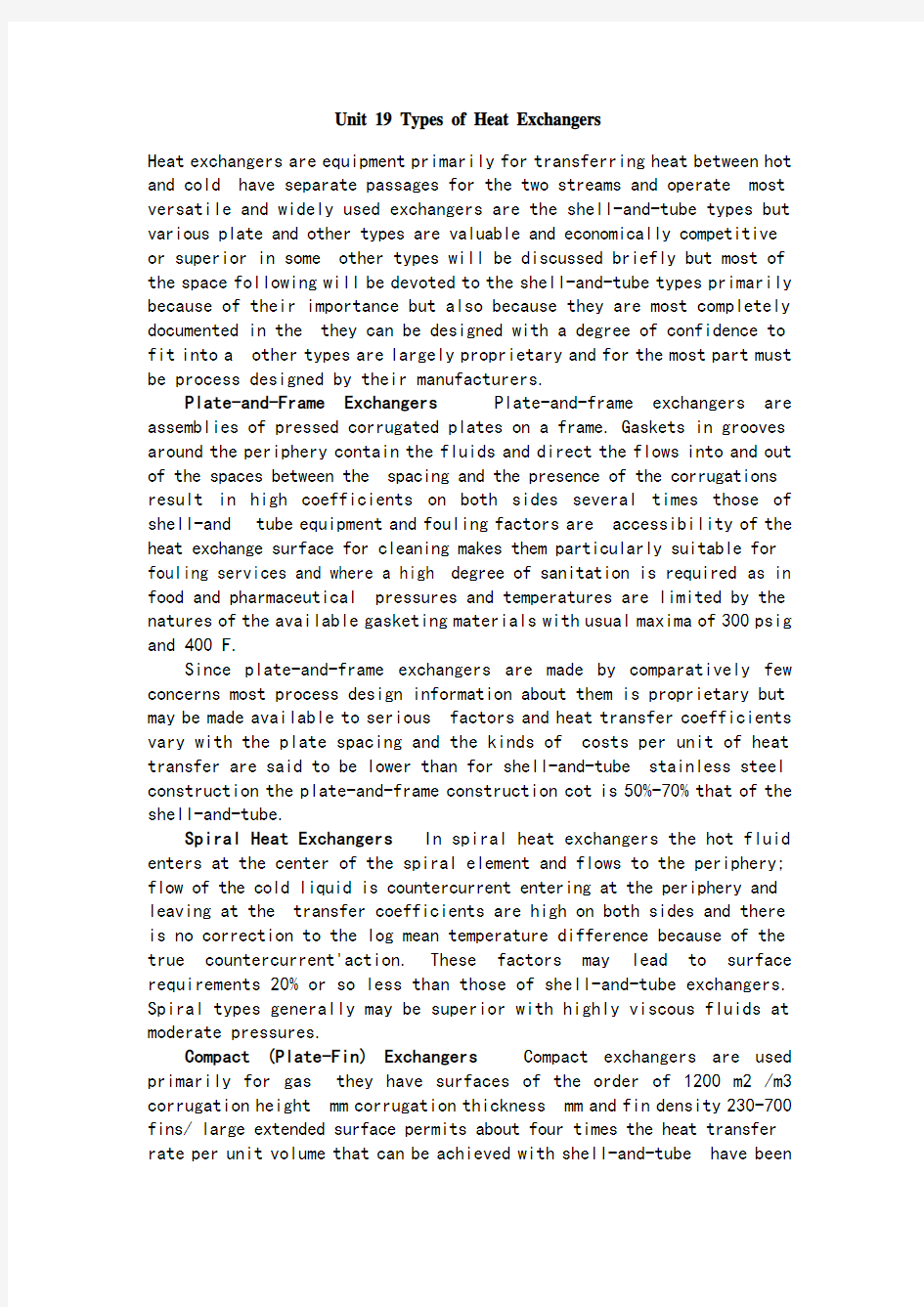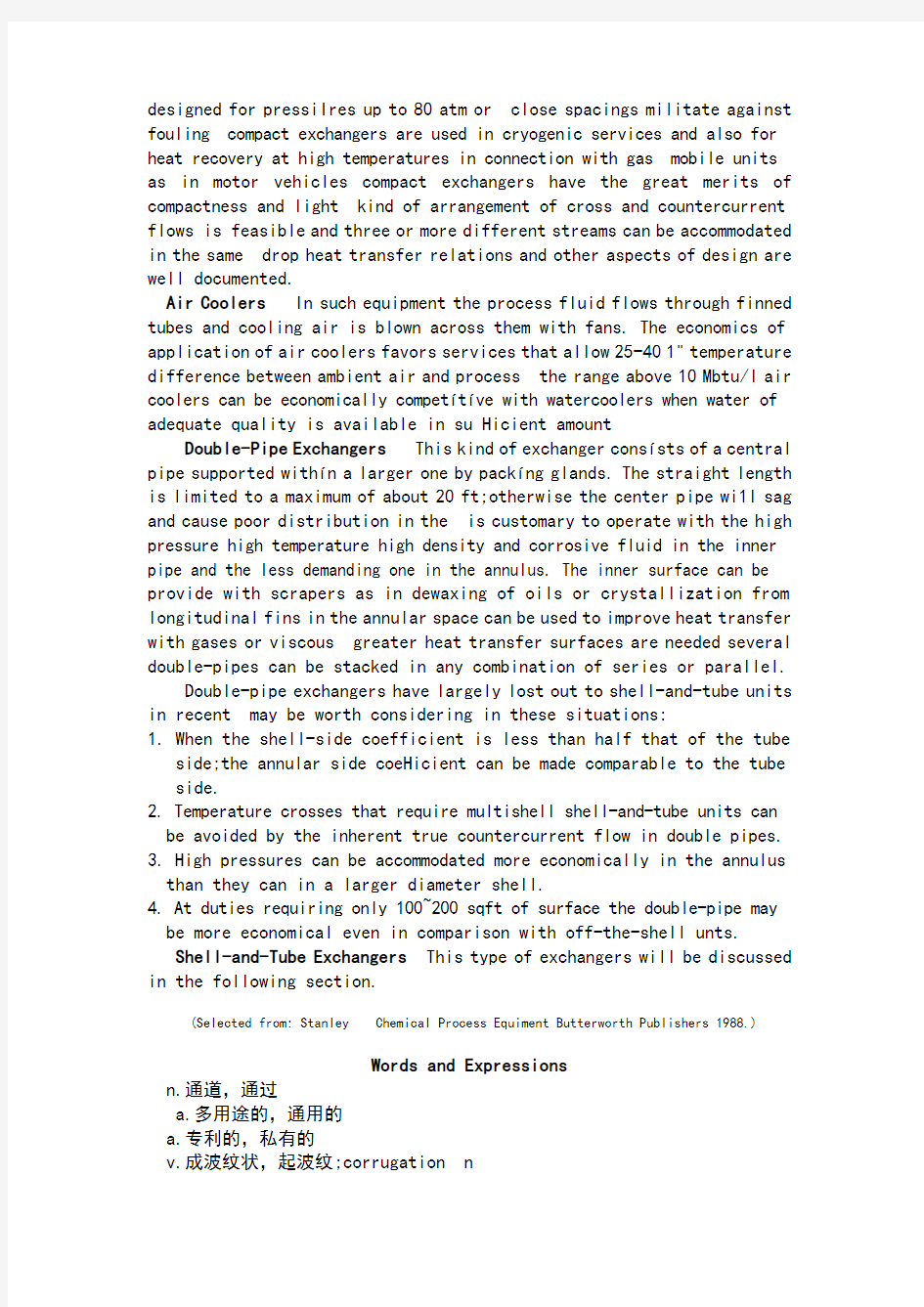

Unit 19 Types of Heat Exchangers
Heat exchangers are equipment primarily for transferring heat between hot and cold have separate passages for the two streams and operate most versatile and widely used exchangers are the shell-and-tube types but various plate and other types are valuable and economically competitive or superior in some other types will be discussed briefly but most of the space following will be devoted to the shell-and-tube types primarily because of their importance but also because they are most completely documented in the they can be designed with a degree of confidence to fit into a other types are largely proprietary and for the most part must be process designed by their manufacturers.
Plate-and-Frame Exchangers Plate-and-frame exchangers are assemblies of pressed corrugated plates on a frame. Gaskets in grooves around the periphery contain the fluids and direct the flows into and out of the spaces between the spacing and the presence of the corrugations result in high coefficients on both sides several times those of shell-and-tube equipment and fouling factors are accessibility of the heat exchange surface for cleaning makes them particularly suitable for fouling services and where a high degree of sanitation is required as in food and pharmaceutical pressures and temperatures are limited by the natures of the available gasketing materials with usual maxima of 300 psig and 400 F.
Since plate-and-frame exchangers are made by comparatively few concerns most process design information about them is proprietary but may be made available to serious factors and heat transfer coefficients vary with the plate spacing and the kinds of costs per unit of heat transfer are said to be lower than for shell-and-tube stainless steel construction the plate-and-frame construction cot is 50%-70% that of the shell-and-tube.
Spiral Heat Exchangers In spiral heat exchangers the hot fluid enters at the center of the spiral element and flows to the periphery; flow of the cold liquid is countercurrent entering at the periphery and leaving at the transfer coefficients are high on both sides and there is no correction to the log mean temperature difference because of the true countercurrent'action. These factors may lead to surface requirements 20% or so less than those of shell-and-tube exchangers. Spiral types generally may be superior with highly viscous fluids at moderate pressures.
Compact (Plate-Fin) Exchangers Compact exchangers are used primarily for gas they have surfaces of the order of 1200 m2 /m3 corrugation height mm corrugation thickness mm and fin density 230-700 fins/ large extended surface permits about four times the heat transfer rate per unit volume that can be achieved with shell-and-tube have been
designed for pressiIres up to 80 atm or close spacings militate against fouling compact exchangers are used in cryogenic services and also for heat recovery at high temperatures in connection with gas mobile units as in motor vehicles compact exchangers have the great merits of compactness and light kind of arrangement of cross and countercurrent flows is feasible and three or more different streams can be accommodated in the same drop heat transfer relations and other aspects of design are well documented.
Air Coolers In such equipment the process fluid flows through finned tubes and cooling air is blown across them with fans. The economics of application of air coolers favors services that allow 25-40 1" temperature difference between ambient air and process the range above 10 Mbtu/l air coolers can be economically competítíve with watercoolers when water of adequate quality is available in su Hicient amount
Double-Pipe Exchangers This kind of exchanger consísts of a central pipe supported withín a larger one by packíng glands. The straight length is limited to a maximum of about 20 ft;otherwise the center pipe wi1l sag and cause poor distribution in the is customary to operate with the high pressure high temperature high density and corrosive fluid in the inner pipe and the less demanding one in the annulus. The inner surface can be provide with scrapers as in dewaxing of oils or crystallization from longitudinal fins in the annular space can be used to improve heat transfer with gases or viscous greater heat transfer surfaces are needed several double-pipes can be stacked in any combination of series or parallel.
Double-pipe exchangers have largely lost out to shell-and-tube units in recent may be worth considering in these situations:
1. When the shell-side coefficient is less than half that of the tube
side;the annular side coeHicient can be made comparable to the tube side.
2. Temperature crosses that require multishell shell-and-tube units can be avoided by the inherent true countercurrent flow in double pipes.
3. High pressures can be accommodated more economically in the annulus than they can in a larger diameter shell.
4. At duties requiring only 100~200 sqft of surface the double-pipe may be more economical even in comparison with off-the-shell unts.
Shell-and-Tube Exchangers This type of exchangers will be discussed in the following section.
(Selected from: Stanley Chemical Process Equiment Butterworth Publishers 1988.)
Words and Expressions
n.通道,通过
a.多用途的,通用的
a.专利的,私有的
v.成波纹状,起波纹;corrugation n
n.沟,槽
n.系数
n.密封垫片
v.弄脏,堵塞;fouling factor 污垢系数
n.卫生
a.制药的;药物的
n. ; a.逆流
n.翅片;v.装翅片
v.妨碍,起作用
a.冷冻的,低温的
n.恢复,回收,再生
n.填料盖,密封套
v.下垂,下沉
n.环状空间; annular a环形的.
v.脱蜡
n.结晶,结晶体
n.堆积,烟囱
α.内在的,固有的
v.调节,适度,容纳
Unit 19 换热器的种类
换热器起初是为了在热流和冷流中传热。对两种冷热流体一般有单独的通道,一般是连续性操作。最通用的换热器是壳管式换热器。但是不同种类板式和其他形式是有价值的和经济竞争能力。虽然一些其他形式也被讨论,但是接下来大部分都在讨论壳管式的。起初是因为它们的重要性也是应为他们在文献中由较完整的记载。因袭它们可以以一种适当过程的准确标准被设计。其他类型的基本上市带有专利性的,并且多数必须有他们的制造厂来进行工艺设计。
板框式换热器板框式换热器是在一个结构上压紧波纹板的装配体。围在边缘的够槽中密封垫片含有液体,并且控制板间液体的流入与流出空间。紧密的缝隙和波纹的板框换热器,在两侧的上部达到了管壳式换热器的几倍,而且板框式换热器的污垢系数较小。换热表面对于清扫的容易性德尔板框式换热器特别适用于污垢设备,也适用于卫生要求较高的行业,比如制药和食品工业,受到可能的垫圈式的密封材料性能的影响,一般最高压力值为300 psig,最高温度为400 F0.。
由于较少气液制造板框式换热器,大多数关于板框式换热器的工艺设计资料到有专利性,但也许提供给负责的工程师。摩擦饮食和热传递系数碎着班的空间和波纹的种类变化。泵花费的每个热传递单元比壳管式设备低。用纯钢制造板框式换热器的费用是管壳式的50~70%。
螺旋型换热器在螺旋形换热设备中,热流进入螺旋单元的中心,并且流到边缘。冷流体是逆流的。在边缘进入并在中心位置流出。在两边热传递系数较高。由于真正的逆流形式没有原来形式的温差,这些因素可能导致表面要求20%或更小的壳管式换热器。螺线形式对于中等压力的高粘性流体比较适合。
翘片式换热器翘片式换热器首先被应用在油气设备中。典型的翘片式换热器在单位体积上有1200平方米的表面积,翘片高度~11.8 mm,翘片的厚度是0. 2~0. 6 mm,片的密度是230~700片每米。在单位体积上翘片式换热器是壳
管式换热器的4倍。
翘片式换热器的操作压力设计为80atm。因为翘片式换热器之间的间距小,所以不适合易堵塞的设备。从商业上说,翘片式换热器适用于低温设备,也是用于与汽轮机相关的高温恢复设备。对于动力设备来说,比如在有发动机的交通工具中,翘片式换热器有结构紧凑和质量轻的优点。错流和逆流的任何排列形式都是可行的,并且在同一设备中可以安排三种或三种以上的流束,压力下降、热交换关系的设计其他方面被很好的记载。
空气冷却器这种设备是指由流体流过翘片式的管道,并且有风扇冷却的空气通过管道。考虑空气冷却器的经济性,可以允许流体与周围空气和出口的温0。荡船热效率超过每小时1千万英热时单位时,空气冷却器与水差为25~40 F
满足要求且供应量充足时,与水冷在经济上不分上下。
套管式换热器套管式换热器是由一个尺寸比较大的和中间一个尺寸比较小的中央管通过塑料密封套连接而成。直线长度被限制在20 ft,否则中心管将下沉并且使环面的分配空间较小。一般情况,高温、高压、高密度和腐蚀性的液体放在内管上,较小要求的液体被放在外侧管子上。当在处理石油脱蜡和液体结晶时,内表面上应该提供刮刀。在环状的空间上,轴向翘片可以改善气体和粘性流体的热交换效率。假如应用较大的热交换表面。套管可以排布堆积起来,也可以应用平行方式。这些套管式换热器已经逐渐被管壳式换热器所取代。在以下情况下,是值得考虑的。
(1)当壳侧系数比管侧系数一样小时,这时壳侧系数可以与管侧相比了
(2)我们可以在套管式换热器中采用真正意义上的逆流来代替,因为温度较高需要多个套管单元。
(3)在与大直径壳体相比,我们的环装空间是使用较高压力来满足经济性能
(4)而与开放式壳体换热器相比,当我们的换热器表面仅仅是100 ~ 200 sqft时,我们套管式换热器有较高的经济性
壳管换热器这种换热器将在以后几章讨论。
Notes
①本句可译为:“其他类型基本上是带有专利性的,并且多数必须由它们的制造厂进行工艺设计”。
②本句可译为:“由于较少企业制造板框式换热器,大多数关于板框式换热器的工艺设计资料是带有专利性的,但也许可以提供给负责任的工程师”。“N isavailable to M”,M可以得到N.句中的“concers”作企业,财团解释。
③本句可译为:“错流和逆流的任何排列形式都是可行的,并且在同一设备中可以安排三种或多种流束”。
④本句可译为:“当传热速率超过每小时1千万英热单位时,空气冷却器与水质满足要求且供应量充足时水冷却器在经济性上不相上下”。
Exercises
1. What type of heat exchangers is most widely used in industries
2. In what situations may the double-pipe exchangers be used
3. Using thefollowing phrases to make English sentences:
(1) be available to (2) be feasible (3) be competitive with
(4) militate against (5) in connection with
4. Put the following phrases into Chinese:122
(1) Plate-and-frame exchangers (2) spiral heat exchangers
(3) plate-fin exchangers (4) air coolers
(5) double-pipe exchangers (6) shell-and-tube exchangers Reading Material 19
Shell-and-Tube Heat Exchangers
S hell-and-tube exchangers are made up of a number of tubes in parallel and series through which one fluid travels and enclosed in a shell through which the other fluid is conducted. The shell side is provided with a number of baffles to promote high velocities and largely more efficient cross flow on the outsides of the tubes. The versatility and widespread use of this equipment has given rise to the development of industrywide standards of shich the most widely observed are the TEMA standards. A typical shell-and-tube exchanger is presented on Fig. 4. 3.
Shell-and-tube exchanger
I-Shelh; 2-Shell coveq; 3-Shell channel; 4-shell cover end flange; 5-Shell nozzle 6-Floating tuesheet; 7-Floating head; 8-Floating head flange; 9-Channel partition; 10-Stationary tubesheet; 11-Channel; 12-Channel cover; 13-Channel nozzle; 14-Tie rods and spacers;
15-Transverse baffles or supportplates; 16-Impingement baffle; 17-Vent connection; 18-Drain connection; 19-Testconnection; 20-Support saddles; 21-Lifting ring;
Baffle pitch , or distance between baffles, normally is 0. 2~1. 0 times the inside diameter of the shell. Both the heat transfer coefficient and the pressure drop depend on the baffle pitch, so that is selection is part of the optimization of the heat exchanger. The window of segmental baffles commonly is abort 25%, but it also is a parameter in the thermal-hydraulic design of the equipment.
In order to simplify external piping, exchangers mostly are built with even number of tube passes. Partitioning reduces the number of the tubes that can be accommodated in a shell of a given size. Square tube pitch in comparison with triangular pitch accommodates fewer tubes but is preferable when the shell side must be cleaned by brushing.
Two shell passes are obtained with a longitudinal baffle. More than two shell passes normally are not provided in a single shell, brt a 4~8 arrangement is thermally equivalent to two 2~4 shells in series, and higher combinations is obtainable with shell-and –tube exchangers, in particular:
● Single phase, condensation or boiling can be accommodated in either the tubes or the shell, in vertical or horizontal positions.
● Pressure range and pressure drop are virtually unlimited, and can be adjusted independently for the two fluids.
● Thermal stresses can be accommodated inexpensively.
● A great variety of materials of construction can be used and may
be different for the shell and tubes.
●Extended surfaces for improved heat transfer can be used on either
side.
● A great range of thermal capacities is obtainable.
●The equipment is readily dismantled for cleaning or repair.
Several considerations may influence which fluid goes on the tube side or the shell side.
The tube side is preferable for the fluid that has the higher pressure, or the higher temperature or is more corrosive. The tube side is less likely to leak expensive or hazardous fluids and is more easily cleaned. Both pressure drop and laminar heat transfer can be predicted more accurately for the tube side. Accordingly, when these factors are critical, the tube side should be selected for that fluid.
Turbulent flow is obtained at lower Reynolds numbers on the shell side, so that the fluid with the lower mass flow preferably goes on that side. High Reynolds numbers are obtained by multipassing the tube side, but at a price.
A substantial number of parameters is involved in the design of a shell-and –tube heat exchanger for specified thermal and hydraulic conditions and desired economics, including: tube diameter, thickness, length, number of passes, pitch, square or triangular; size of shell, number of shell baffles, baffle type, baffle windows, baffle spacing, and so on. For even a modest sized design program, it is estimated that 40 separate logical designs may need to be made which lead to 240=different paths through the logic. Since such a number is entirely too large for normal computer process, the problem must be simplified with some arbitrary decisions based on as much current practice as possible.
(Selected from: Stanley . Chemical Process Publishers,1988.)
Words and Expressions
1. baffle n. 折流板,挡板
2. terminology n. 术语,专业用名词
3. pitch n. 间距,位置
4. optimization n. 最佳化,优选法
5. segmental a. 部分的,扇形的
6. partition v.; n. 隔开,分割
7. condensation n. 冷凝,凝聚
8. dismantal υ. 分解,除去,拆开,拆卸
9. laminar a. 层流的,层状的
10. turbulent a. 湍流的
11. Reynolds number 雷诺数
12. space n. 分隔器,定距器,隔板,垫片,衬套
13. impingement n. 冲击,冲撞,碰撞
14. vent n. 通风管(口),排气管;v. 排水,排出
15. drain n. 排水管,下水道;v. 排水,排空
16. multipass n.; v. ; a. 多通道,多次通过
17. arbitrary a. 任意的,随机的
18. nozzle n. 接管,管口
19. channel n. 通道,渠道;v. 开沟(槽)
20. tubesheet n. 管板
阅读材料19
管壳式换热器
管壳式换热器是由一定数量的内有液体流动的平行管子和将其包围住的内有另一种液体的壳体组成的。壳内有一定数量的折流板以提高管外液体的流速和横流效率。由于换热器的广泛使用及其功能的多样性,使它成为最受TEMA标准关注的工业标准的设备。如图是一典型的管壳式换热器。
折流板间距通常是换热器直径的倍。换热系数和压力降均由折流板的间距决定,所以其选取对于换热器的选择至关重要。弓形挡板的横截面积通常是壳体截面的25%,但也是在热力液压设备设计中的一个参数。为了简化管道,换热器通常采用多管程。在固定的壳体容积中通过分层可以减少管子的数量。方形分布和三角形分布比起来能容纳的管子更少些,但若壳体需经常清洗的话前者更常用。
双管程是由纵向分布的折流板构成的。多于双管程的话通常不仅仅需要单个壳体,2-4个壳体就相当于4-8管程,连接更多壳体就可得到更多管程。
管壳式换热器可以有多种设计方案和适用于多种条件,尤其是:
●单壳程结构冷凝或蒸发可在管中或壳内进行,换热器可水平或垂直放置
●压力分布和压力降不受限制,并可以单独由两种液体控制
●热应力较小
●用多种材料且壳体和管道使用不同种材料时
●可在壳程或管程内增大表面积以增加热交换系数
●需获得更大范围的热容量
●设备易拆卸以便于清洗和维修
一些因素会影响何种液体走管内还是管外
高压、高温、强腐蚀性的液体更适合走管内。在管内,贵重液体不容易泄露,毒性液体也更容易清洗。管内的压力降和换热系数能得以更精确的估算。因此,如果对这些条件有严格的要求的话,液体应走管内。
液体在壳体中流动的雷诺数较低时形成湍流,因此低密度的液体更适于在壳体内流动。采用多管道可获得较高的雷诺数,但造价高。
设计管壳式换热器时,在考虑一定的热力、压力条件和经济性的情况下需要参照涉及到大量的参数,包括:管道直径、管壁厚度、长度,管程数量,间距、方形分布或三角形分布;壳体的尺寸、折流板的数量、类型、横截面积等等。假设仅仅是一个中型的设计,据估计都有40种方案,逻辑上由此产生240=种线路。鉴于这样的数字对于一般的电脑程序来说太庞杂,问题必须根据现有实际情况尽量简化。